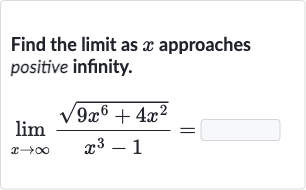AI tutor
Full solution
Q. Find the limit as approaches positive infinity.
- Identify highest power of : Identify the highest power of in the numerator and denominator.In the expression , the highest power of in the numerator inside the square root is , which is equivalent to when taken out of the square root. In the denominator, the highest power of is .
- Divide numerator and denominator: Divide the numerator and the denominator by the highest power of in the denominator.To simplify the limit, we divide every term by , which is the highest power of in the denominator.
- Simplify expression inside the limit: Simplify the expression inside the limit.After dividing by , we get:Now, as approaches infinity, and approach .
- Evaluate the limit: Evaluate the limit as approaches infinity. \lim_{x \to \infty}\left(\frac{\sqrt{\(9\)+(\(4\)/x^{\(4\)})}}{\(1\)-(\(1\)/x^{\(3\)})}\right) = \frac{\sqrt{\(9\)+\(0\)}}{\(1\)\(-0\)} = \frac{\sqrt{\(9\)}}{\(1\)} = \(3

